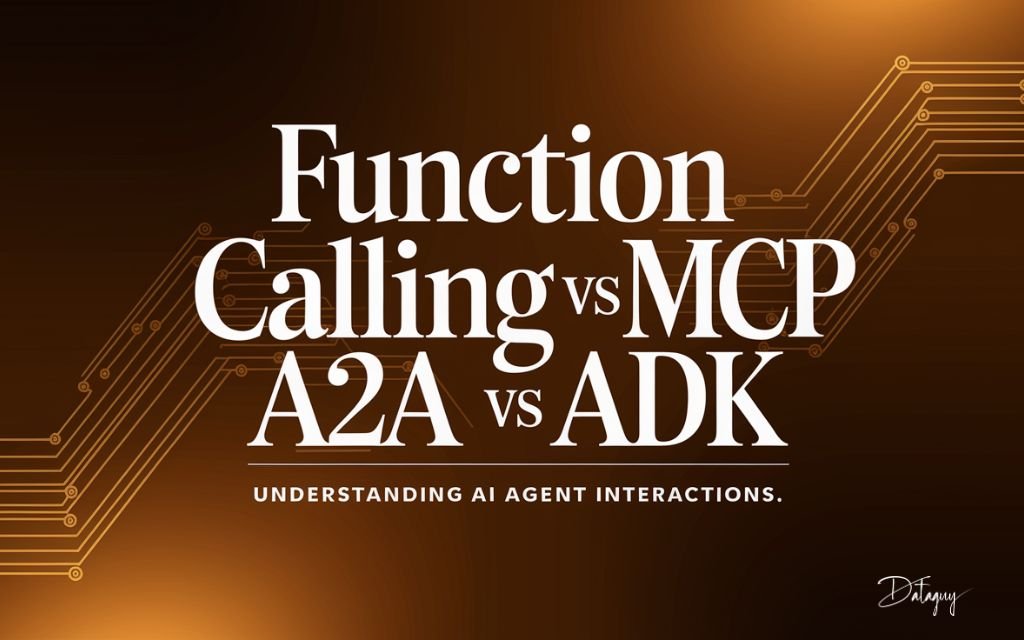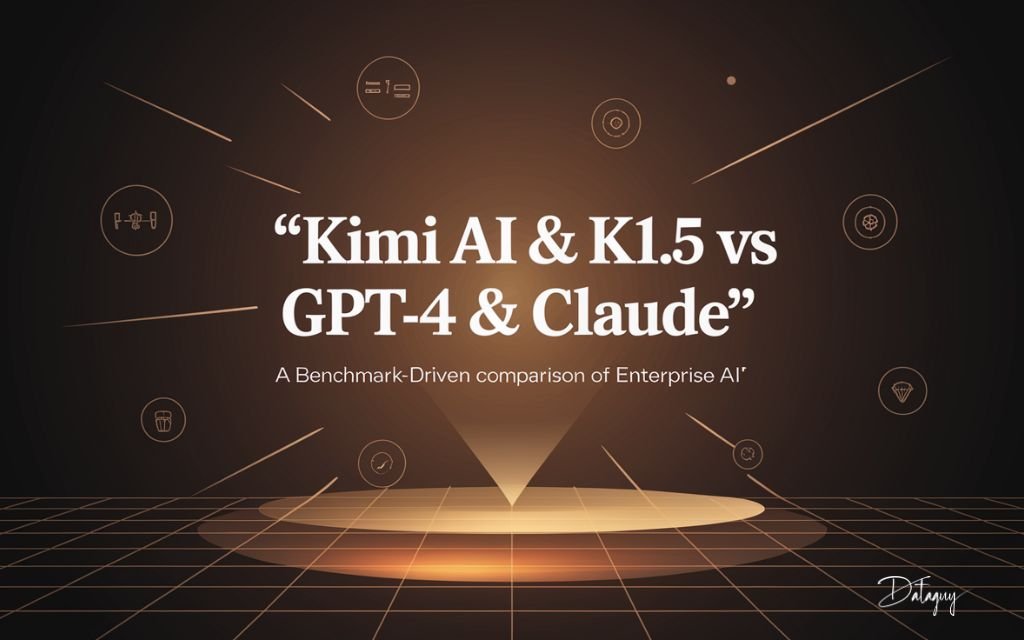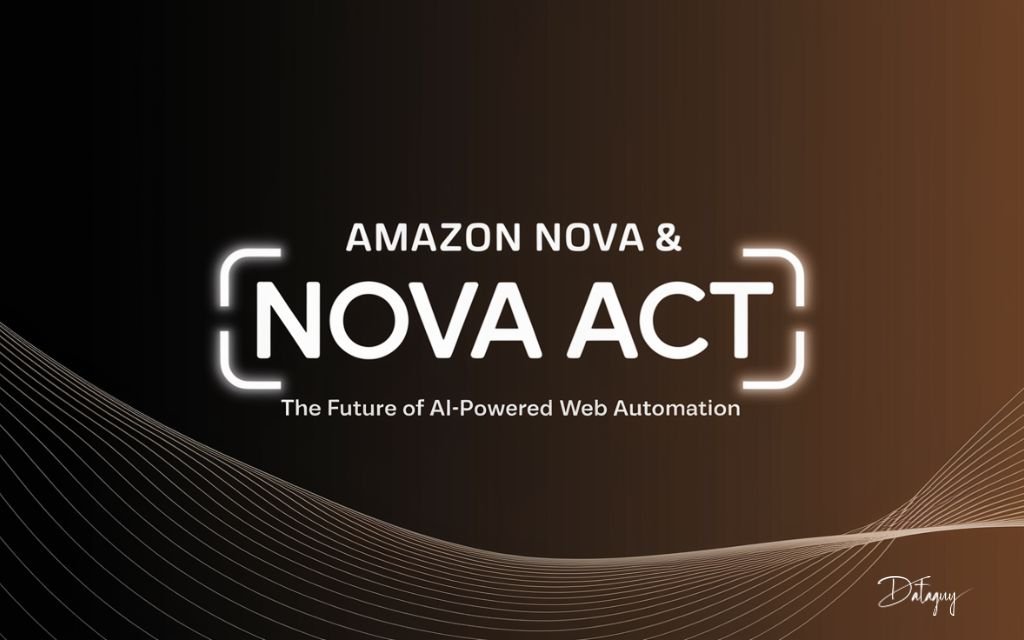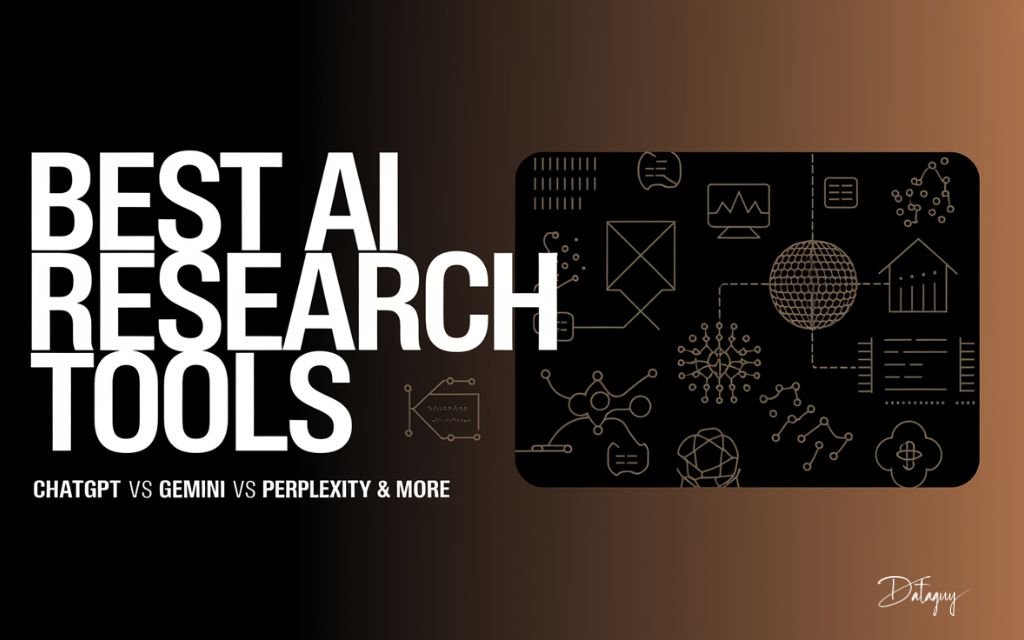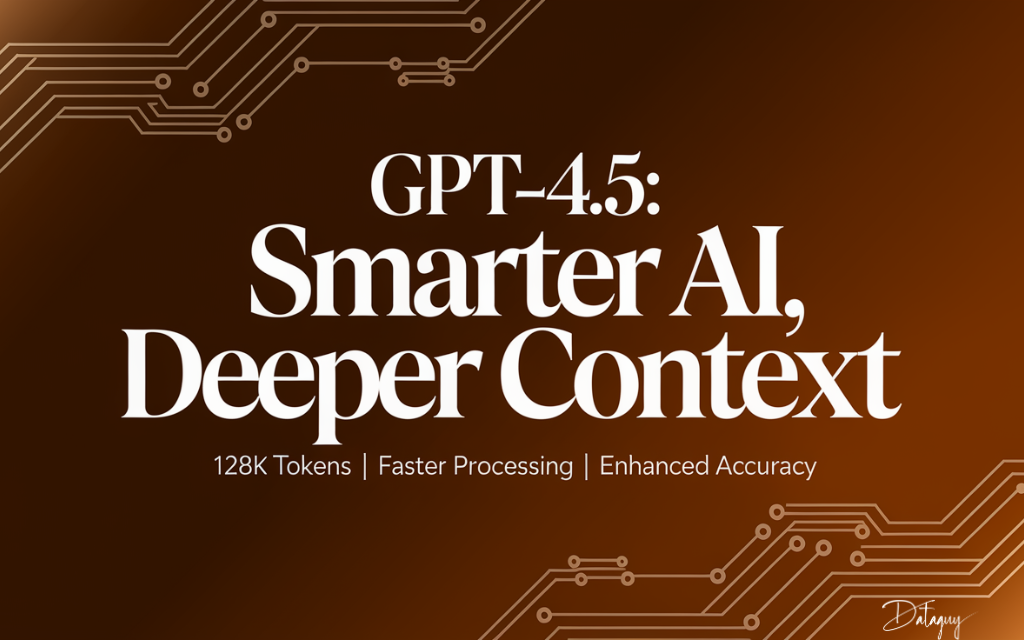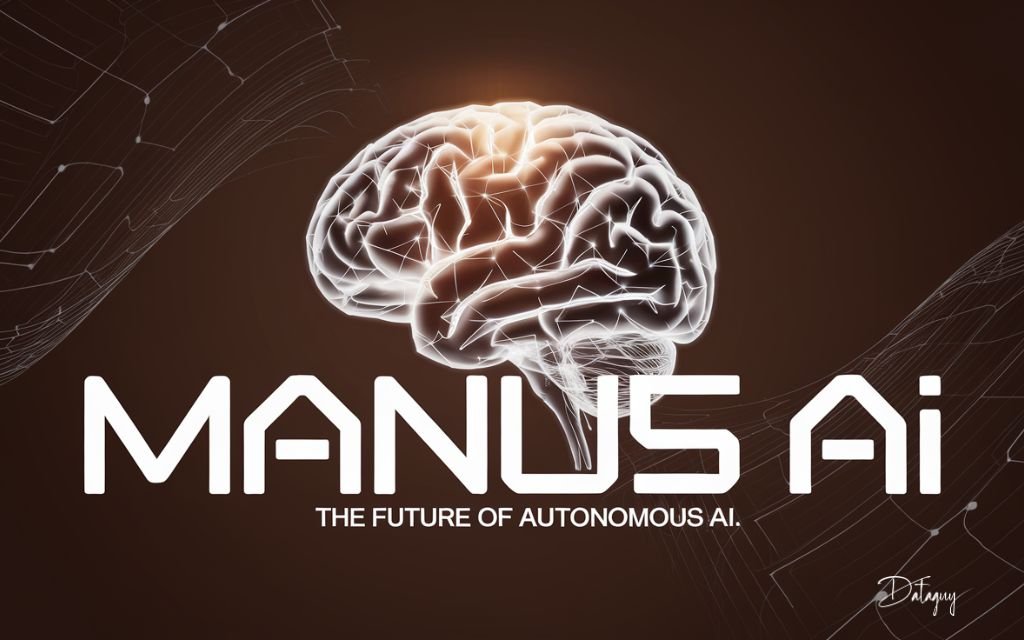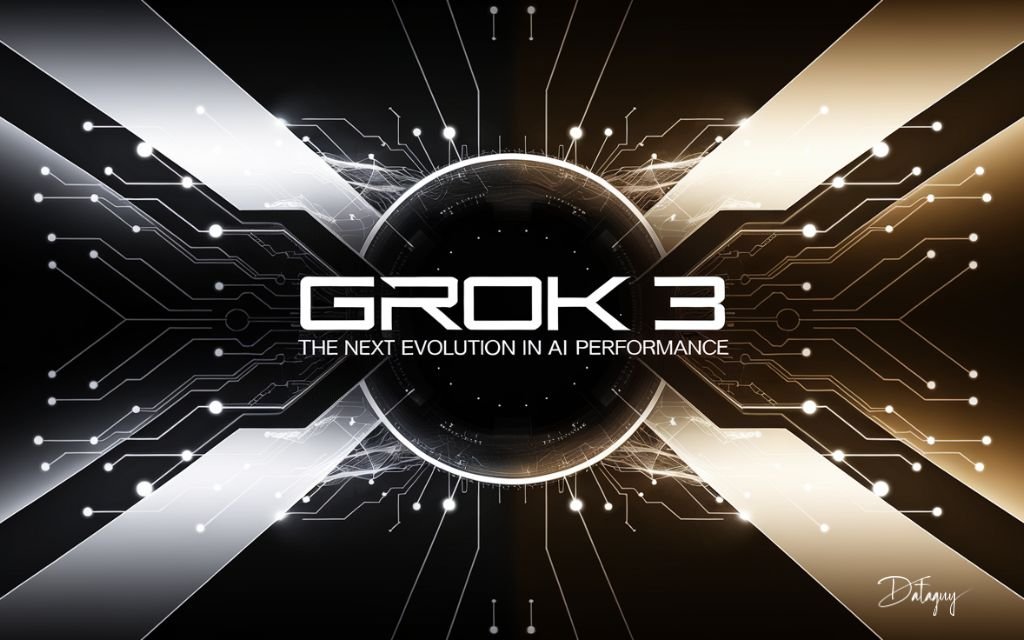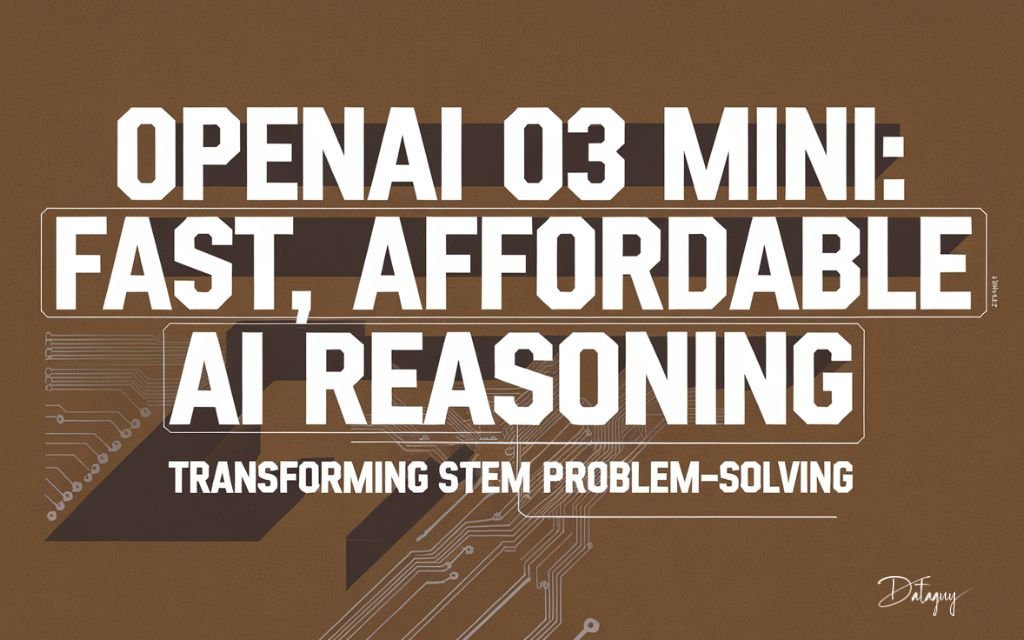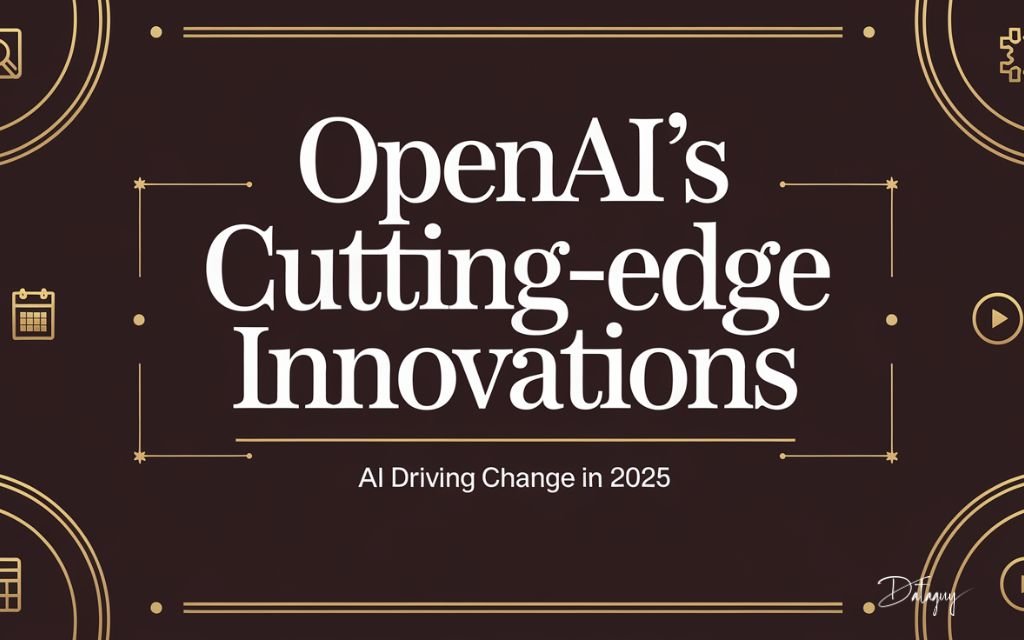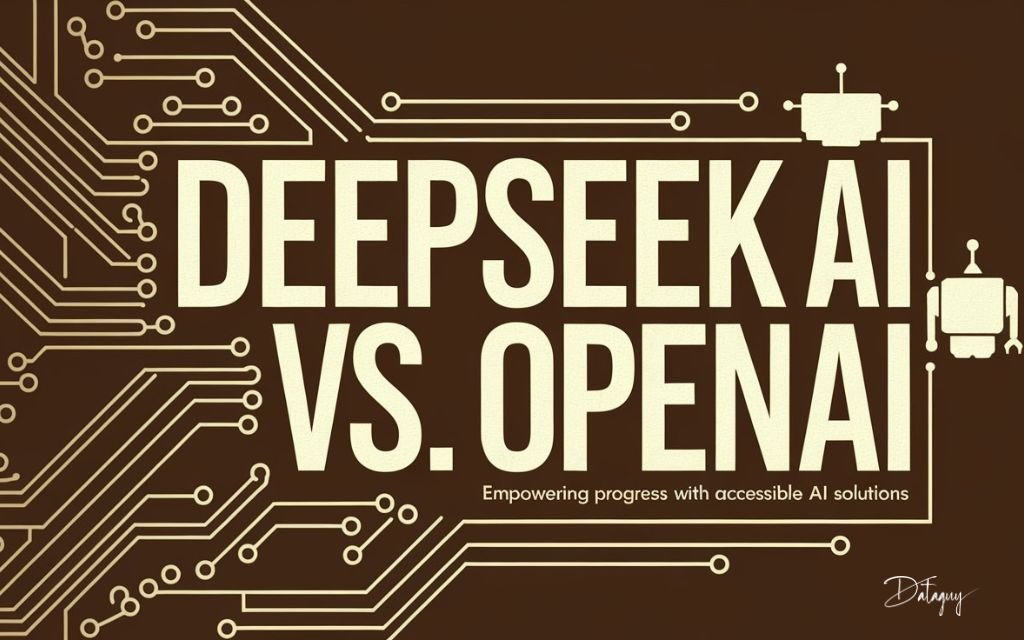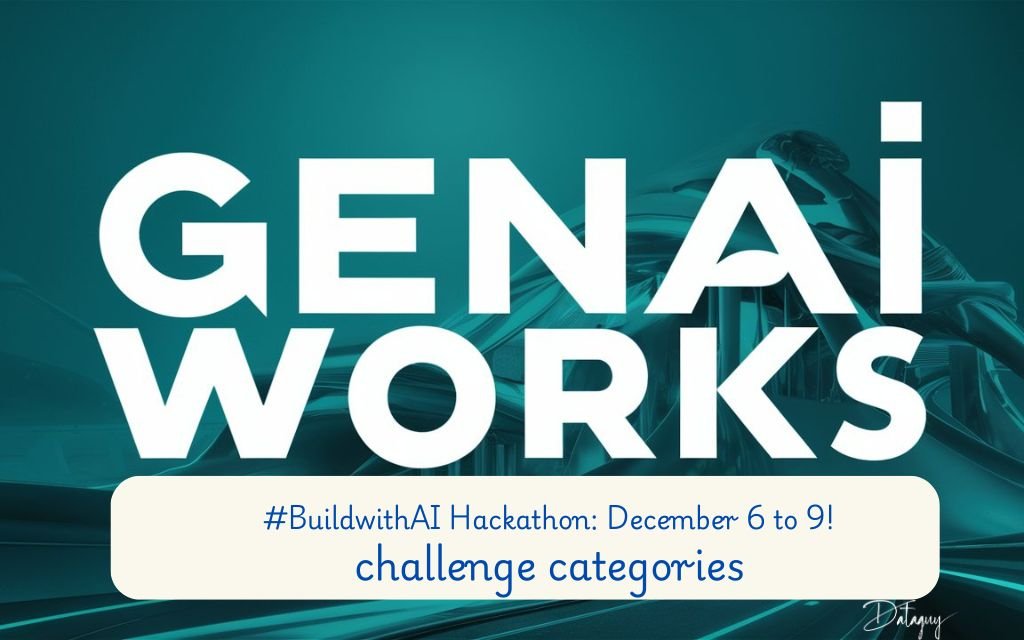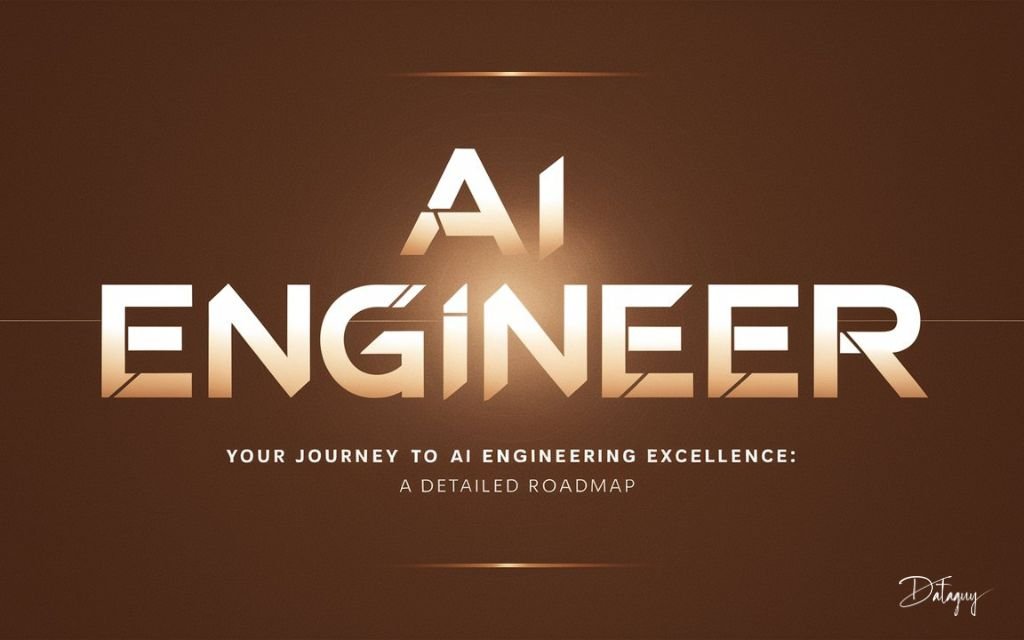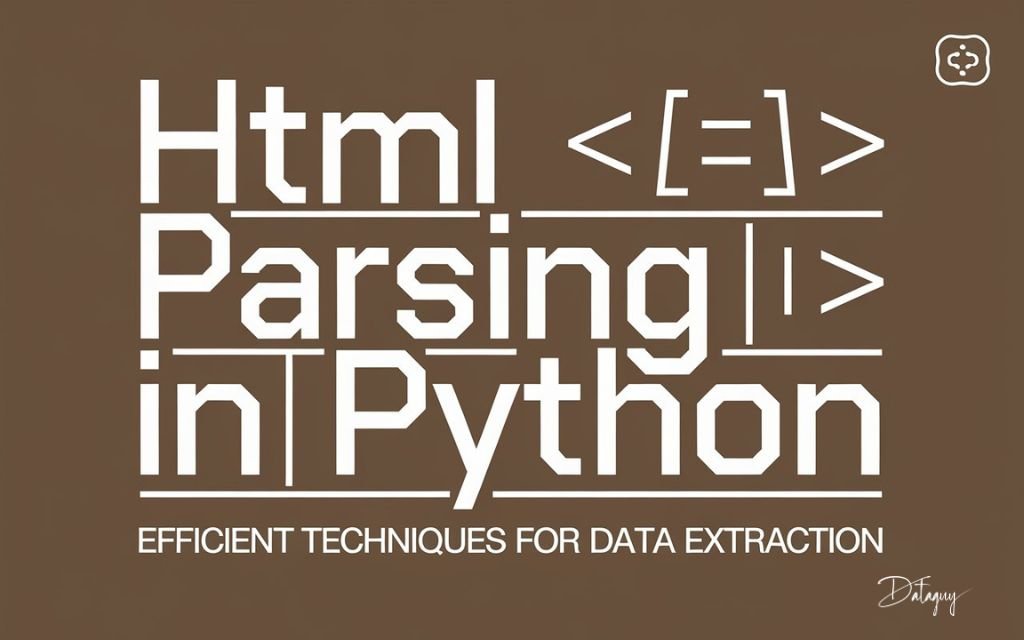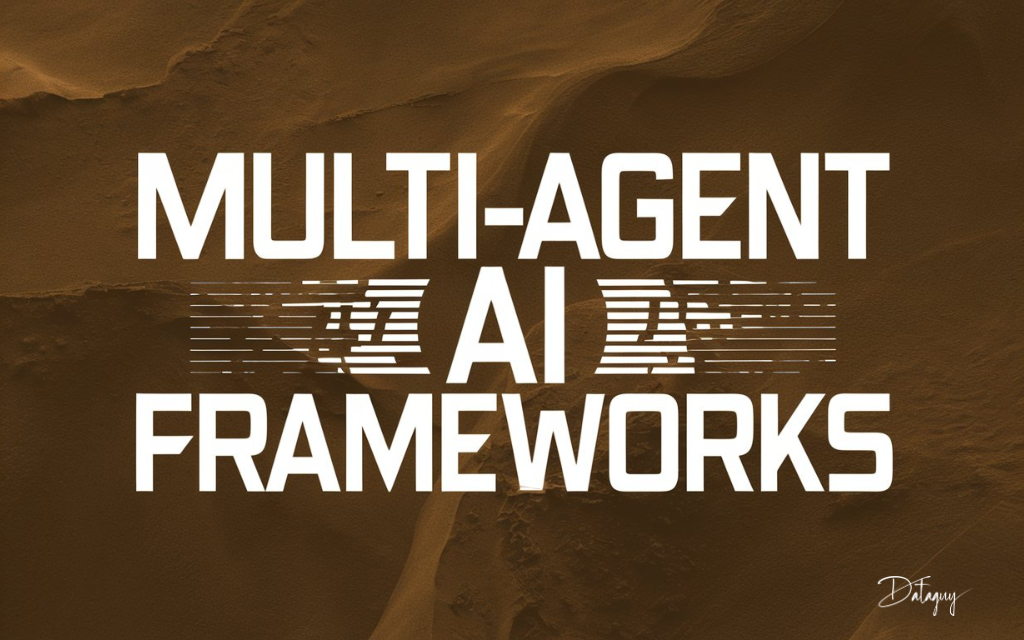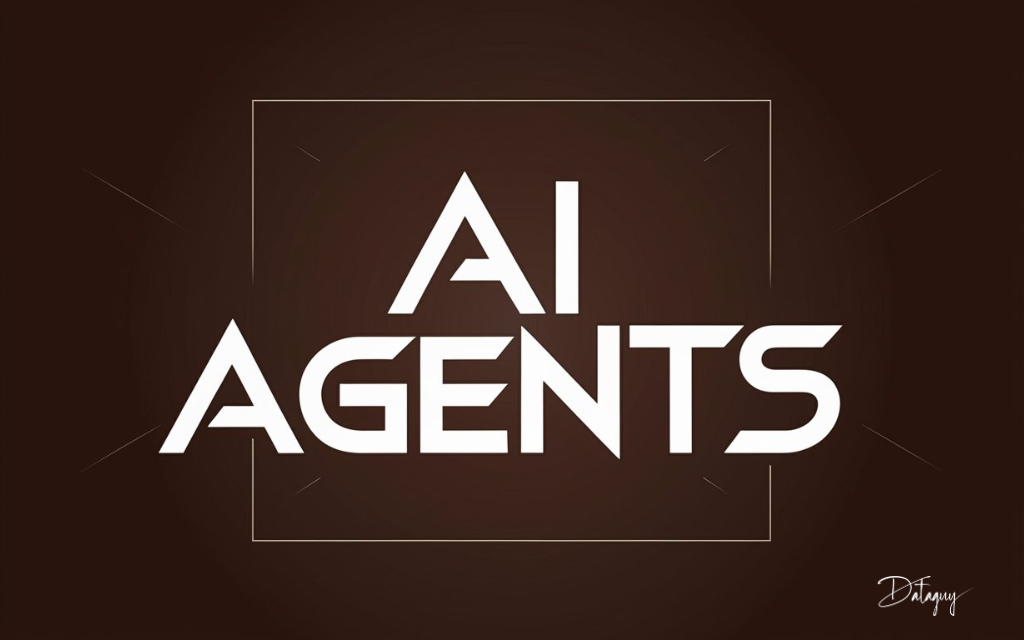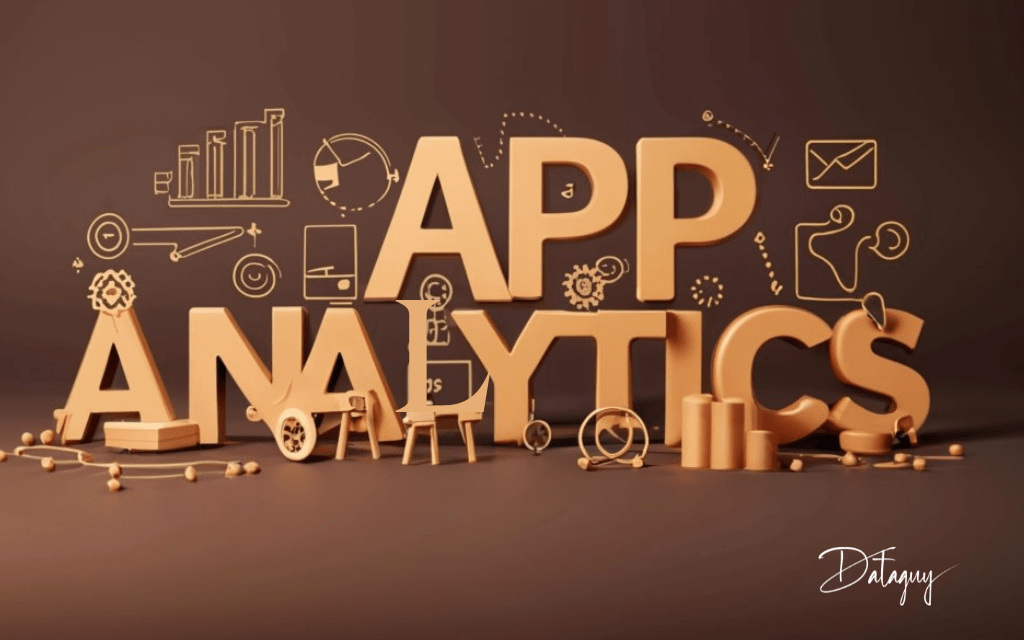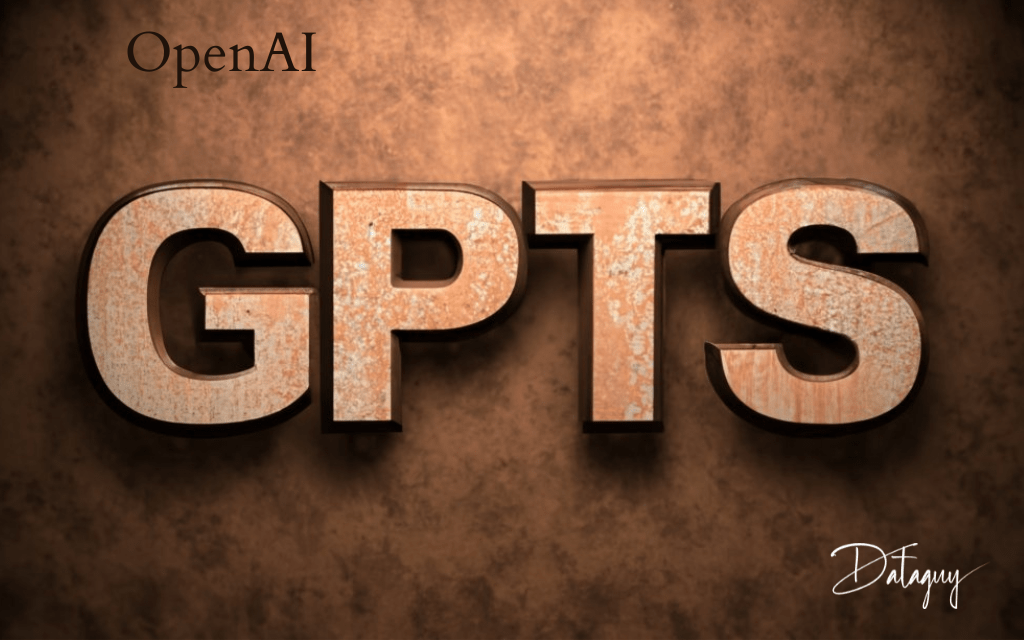Level up your data IQ: Explore cutting edge trends with our curated collection of expert articles
This page serves as your compass in the dynamic landscape of data and analytics. We meticulously curate the latest articles on critical topics like AI, ML, Big Data, Data Science, and Emerging Technologies.

Your One-Stop Shop for Data-Driven Success:
The world is awash in data, a swirling current of insights waiting to be discovered. But navigating this deluge requires a compass, a guidepost to the most captivating corners and the hidden treasures within. This is where the Data Analytics Hub emerges, your portal to the cutting edge of innovation, where AI, Big Data, Web3, and beyond collide in a transformative symphony.
Posts
- MCP vs A2A vs ADK: Key Differences in AI Agent Integration from Anthropic and Google (24 April 2025)
- Agent Development Kit (ADK): Build Scalable Multi-Agent AI Systems with Google's Open Framework (22 April 2025)
- OpenAI o3 and o4-mini Unleashed: Tool-Using AI Breakthrough (21 April 2025)
- GPT-4.1 Prompting Guide: Build Agents, Use Tools, and Plan (21 April 2025)
- Kimi AI & K1.5: Real-Time, Multimodal AI Outperforming GPT-4 and Claude (16 April 2025)
- GPT-4.1: OpenAI’s Fastest, Smartest, and Most Cost-Efficient Model Yet (15 April 2025)
- Google Agent2Agent (A2A) Protocol: Enterprise AI Collaboration Standard (12 April 2025)
- Gemma 3: Google’s Multimodal, Open-Source AI Breakthrough (11 April 2025)
- Llama 4 Models: MoE Architecture, Multimodal AI & 10M Token Context (11 April 2025)
- Vibe Coding: The Future of AI-Powered Software Development (6 April 2025)
- OpenAI Academy: AI Education for the Next Generation of Innovators (3 April 2025)
- Amazon Nova & Nova Act: The Future of AI-Powered Web Automation (1 April 2025)
- ERNIE 4.5 & X1: Baidu's AI Breakthrough at 1% of GPT-4.5's Cost (31 March 2025)
- GPT-4o Image Generation: The Future of AI Creativity & Visual Design (29 March 2025)
- Gemini 2.5 Pro vs. 2.0 Flash: AI Model Comparison, Benchmarks & Pricing (28 March 2025)
- Gemini 2.5 Pro: A Breakthrough in AI-Powered Coding and Reasoning (28 March 2025)
- Grok 3 AI: A Game-Changer in AI Research (26 March 2025)
- Sunita Williams' Historic Space Mission: Challenges, Research & Record-Breaking Achievements (20 March 2025)
- Top 5 AI Research Tools Compared: ChatGPT, Gemini, Perplexity & More (20 March 2025)
- DeepSeek AI for Research: Strengths, Weaknesses, and Security Risks Explained (20 March 2025)
- OpenAI GPT-4.5: A Deep Dive into Its Advancements and Capabilities (19 March 2025)
- Claude 3.7 Sonnet vs. 3.5 – Key Upgrades And Performance Boost (18 March 2025)
- MCP (Model Context Protocol): Standardizing AI Model Collaboration (18 March 2025)
- Manus AI: The First Fully Autonomous AI Agent You Need to Know About (17 March 2025)
- Grok 3: How Elon Musk’s AI Outperforms GPT-4o, Gemini & Claude 3.5 (19 February 2025)
- Deep Research by OpenAI: Your AI-Powered Research Agent (3 February 2025)
- OpenAI o3‑mini: Revolutionizing AI Reasoning for Faster STEM Solutions (3 February 2025)
- Qwen 2.5: Alibaba’s AI Model vs. GPT-4o & DeepSeek-V3 (29 January 2025)
- Janus-Pro-7B: The AI Model Redefining Multimodal Innovation (28 January 2025)
- OpenAI's Latest Features: ChatGPT and Operator Unveiled (24 January 2025)
- DeepSeek R1: A Powerful, Free Open Source AI Model with Unmatched Reasoning (23 January 2025)
- AI Agents Explained: Benefits, Use Cases, and the Road Ahead | Data Guy (1 January 2025)
- What is RAG? The Ultimate Guide to Retrieval-Augmented Generation in AI (1 January 2025)
- Veo 2 or Sora: Your Guide to Choosing the Perfect AI Video Companion (23 December 2024)
- Gemini 2.0 by Google: Smarter AI for the Agentic Era (22 December 2024)
- OpenAI o3 Model: Unveiling a New Era of AI Reasoning in 2025 (21 December 2024)
- Top 10 AI Research Papers on 11.28.2024 | Daily AI Insights (28 November 2024)
- Generative AI, RAG, and AI Agents: A Deep Dive into Emerging AI Technologies (22 November 2024)
- Top 10 AI Research Papers on 11.19.2024 | Daily AI Insights (19 November 2024)
- BuildwithAI Hackathon 2024: Compete for $25,000 & Showcase Your AI Skills (14 November 2024)
- Midjourney : The AI Art Tool Redefining Creativity and Design | Features & Use Cases (13 November 2024)
- Top 10 AI Research Papers on 11.11.2024 | Daily AI Insights (11 November 2024)
- Best AI Tools for Creativity, Productivity & Innovation | AI Software Reviews (11 November 2024)
- Top 10 AI Research Papers on 11.01.2024 | Daily AI Insights (1 November 2024)
- Top 10 AI Research Papers on 10.25.2024 | Daily AI Insights (25 October 2024)
- Top 10 AI Research Papers on 10.21.2024 | Daily AI Insights (21 October 2024)
- Top 10 AI Research Papers on 10.18.2024 | Daily AI Insights (18 October 2024)
- Top 10 AI Research Papers on 10.16.2024 | Daily AI Insights (16 October 2024)
- Top 10 AI Research Papers on 10.14.2024 | Daily AI Insights (14 October 2024)
- Top 10 AI Research Papers on 10.10.2024 | Daily AI Insights (10 October 2024)
- The Role of UI and UX in Building Data-Centric Products (8 October 2024)
- Top 10 AI Research Papers on 10.07.2024 | Daily AI Insights - Data Guy (7 October 2024)
- Top 10 AI Research Papers on 10.03.2024 | Daily AI Insights - Data Guy (3 October 2024)
- Top 10 AI Research Papers on 10.01.2024 | Daily AI Insights - Data Guy (1 October 2024)
- Top 10 AI Research Papers on 9.30.2024 | Daily AI Insights - Data Guy (30 September 2024)
- Top 10 AI Research Papers on 9.27.2024 | Daily AI Insights - Data Guy (27 September 2024)
- Top 10 AI Research Papers on 9.26.2024 | Daily AI Insights - Data Guy (26 September 2024)
- Top 10 AI Research Papers on 9.25.2024 | Daily AI Insights - Data Guy (25 September 2024)
- Poetic Overview of Data Roles: Analysts, Engineers, and More (17 September 2024)
- OpenAI o1: Redefining AI Reasoning for Science, Math, and Coding (16 September 2024)
- The Evolution of Database Technologies: A Comprehensive Guide (12 September 2024)
- How Data Architectures Evolved: Warehouses, Lakes, and Meshes (11 September 2024)
- AI Engineer Roadmap: A Complete Guide for Aspiring AI Professionals (10 September 2024)
- Prompt Engineer: Mastering AI Inputs for Optimal Results (9 September 2024)
- HTML Parsing Made Easy: Python Techniques Every Developer Should Know (29 August 2024)
- Phoenix AI: Revolutionizing AI Observability (13 August 2024)
- Flower AI: Revolutionizing Federated Learning for Privacy in AI (12 August 2024)
- AutoGen vs CrewAI: A Comprehensive Comparison of Multi-Agent AI Frameworks (7 August 2024)
- AI Agents: The Future of Intelligent Technology (26 July 2024)
- Haystack AI: Build Production-Ready LLM Apps | Open-Source Framework (26 July 2024)
- Mistral AI's Latest Triumph: Mistral Large 2 Redefines Language Models (25 July 2024)
- Groq AI: Revolutionizing Computing with Lightning-Fast AI Inference (24 July 2024)
- Llama 3.1: Meta's Groundbreaking Open-Source AI Model | 405B Parameters (24 July 2024)
- GPT-4o Mini: OpenAI's Affordable AI Revolution | 60% Cheaper (19 July 2024)
- The Ultimate Guide to Claude AI Models: Discover Opus, Sonnet, and Haiku (10 July 2024)
- Claude 3.5 Sonnet: Redefining AI Intelligence and Speed (9 July 2024)
- Ollama: The Game-Changer in Local AI Deployment (6 July 2024)
- Claude AI: Anthropic's Revolutionary Language Model Family (5 July 2024)
- LangChain vs LlamaIndex: Which One Suits Your LLM Needs? (25 June 2024)
- LlamaIndex: The Ultimate Data Integration Framework for LLMs (24 June 2024)
- Unveiling the Power of LangChain and Retrieval-Augmented Generation (RAG) (23 June 2024)
- RAG, GraphRAG, and LLMs for Advanced AI Solutions (23 June 2024)
- The Ultimate GenAI glossary: Key Terminology and Jargon Explained (6 June 2024)
- LLMOps vs MLOps: Mastering AI Operations for Large Language Models (LLMs) and Beyond (24 May 2024)
- Understanding GPT-4, GPT-4 Turbo, and GPT-4o: Key Differences and Applications (21 May 2024)
- GPT-4o: The Omni-Model Revolutionizing Human-Computer Interaction (16 May 2024)
- Gemini 1.5 Pro : Google's AI with Mixture-of-Experts (MoE) architecture (22 February 2024)
- SORA: OpenAI's Text-to-Video Generation Model (16 February 2024)
- Project Management Mastery: Elevate Your Workflow Today (7 January 2024)
- Product Management Demystified: From Vision to Value (5 January 2024)
- Business Strategy and Implementation: A Roadmap to Organizational Success (26 December 2023)
- Digital Marketing: Secrets to Online Triumph and Brand Excellence (26 December 2023)
- Mastering Research Paper Writing: A Comprehensive Guide (21 December 2023)
- Web3 Demystified: Your Guide to the Future Internet Revolution (18 December 2023)
- Mastering Large Language Models (LLMs): The Power of Prompt Engineering (17 December 2023)
- Prompt Engineering: The Secret Weapon for Mastering Large Language Models (LLMs) (17 December 2023)
- Blockchain: The Future of Secure Digital Transactions (13 December 2023)
- Big Data: The Fuel of the Future (8 December 2023)
- Cloud Computing: The On-Demand Technology Powerhouse You Need to Know (8 December 2023)
- Data Engineering Mastery: Building a Foundation for Actionable Insights (7 December 2023)
- GEMINI: Unveiling Google's Revolutionary Multimodal AI Model (7 December 2023)
- Data Science Fundamentals: A comprehensive guide (6 December 2023)
- Exploring Artificial Intelligence (AI): Balancing Innovation with Accountability (6 December 2023)
- Machine Learning (ML) Mastery: Empowering Decisions Through Data (6 December 2023)
- GenAI: Exploring Generative AI's Boundless Possibilities (2 December 2023)
- Analytics: The Key to Informed Decision-Making (30 November 2023)
- Mastering App Analytics: Transforming Data into Mobile Success (30 November 2023)
- Social Media Analytics: 9 Essential Aspects for Enhanced Digital Engagement (24 November 2023)
- Web Analytics Mastery for Optimizing Digital Performance (21 November 2023)
- Data Analytics: Decoding the Power of Informed Decision-Making (21 November 2023)
- Marketing Analytics: A Comprehensive Guide for Optimal ROI (21 November 2023)
- Product Analytics: Transforming Data into Strategic Insights (20 November 2023)
- GPT-4 Turbo: Redefining AI Excellence with 128K Context Length (9 November 2023)
- GPTs: Empowering Tomorrow's AI Innovations (8 November 2023)
- GROK AI: Revolutionizing Conversations with Wit, Wisdom, and a Dash of Rebellion (6 November 2023)
- Vector Databases: Powering Modern AI (30 September 2023)
- Prompt Engineering for Business Units (22 September 2023)
- Prompt Engineering for Business Strategy (22 September 2023)
- Prompt Engineering: 90 Frameworks to Revolutionize AI Conversations (14 September 2023)
- Python in Excel: Amplifying Data Analysis and Visualization (24 August 2023)
- ChatGPT Custom Instructions: Personalize Your AI Conversations (16 August 2023)
- LLMs, LangChain, and Diffusion Models Explained (17 July 2023)
- ML Engineer Roadmap: The Journey to Success in Machine Learning Engineering (27 June 2023)
- Data Scientist Roadmap: Your Step-by-Step Guide to Success in Data Science (22 June 2023)
- Data Engineer Roadmap: Your Path to Mastering Data Engineering (20 June 2023)
- OpenAI's Function Calling and API Enhancements (17 June 2023)
- Data Analyst Roadmap: Empowering Your Data-Driven Future (8 June 2023)
- Discover the Power of ChatGPT Plugins: 14 Must-Have Chat Plugins for Enhanced Conversations (25 March 2023)
- GPT-4: OpenAI’s Multimodal Large Language Model (LLM) (18 March 2023)
- ChatGPT: Everything About OpenAI's Conversational AI (12 March 2023)
- ChatGPT API and Whisper : OpenAI’s Solution for Developers (5 March 2023)
- GPT-3 vs InstructGPT OpenAI Language Model: Key Differences (5 March 2023)
- InstructGPT: A Safer and More Aligned Language Model from OpenAI (4 March 2023)
- GPT-3: Everything you need to know about OpenAI's language model (4 March 2023)
- Get Smarter with BARD - The Latest AI Search Feature by Google (7 February 2023)
- Customer Retention (1 January 2023)
Stories
- Vibe Coding: Where AI Meets Flow State (10 April 2025)
- AI Engineering Roadmap: Your Guide to AI Mastery (26 August 2024)
- Data Observability: Master Your Data Systems (26 August 2024)
- Prompt Engineering: Design Better AI Interactions (26 August 2024)
- Mastering Data Management: From Chaos to Clarity (22 August 2024)
- Mastering Data Governance: Your Path to Reliable Data (16 April 2024)
- The Power of Innovative Thinking in Data Analysis (4 April 2024)
- Data Mining: Digging for Information Gold (4 April 2024)
- The Art of Data Visualization: Painting a Picture with Data (3 April 2024)
- Why Data Cleaning is Like Doing Laundry (3 April 2024)
- Mastering the Data Science Recipe (29 March 2024)
- Data Science Kitchen: Where Insights are Cooked (29 March 2024)
- The Art of Finding Patterns: The Key to Mastering Data Analysis (27 March 2024)
- The Power of Storytelling in Data Analysis (27 March 2024)
- Trusting Data: The Key to Objective Analysis (26 March 2024)
- Data vs. Goldfish: Why Data Never Forgets (23 March 2024)
- Why Data Accuracy is Non-Negotiable for Success (14 April 2023)
- Data Silos: The Isolated Islands of Information (14 April 2023)
- Decoding Data Complexity With Puzzle-Solving Skills (14 April 2023)
- Data Literacy: Key to Gaining a Global Perspective (14 April 2023)
- Data Quality: It's Like the Air We Breathe (13 April 2023)
- The Similarities of Raising Toddlers and Managing Data (11 April 2023)
Join the Tribe of Data Enthusiasts:
The Data Analytics Hub is not just a library of articles – it’s a thriving community. Share your discoveries, engage in stimulating discussions, and learn from fellow explorers across the spectrum of data-driven disciplines. We celebrate curiosity, champion continuous learning, and believe that together, we can unlock the boundless potential of data to shape a brighter future!
Stay informed, inspired, and equipped to thrive in the data-powered future.
In the rapidly evolving field of artificial intelligence, understanding the protocols that enable AI agents to interact and collaborate is crucial. This guide delves into Function Calling, MCP, A2A, and ADK, providing insights into how each protocol facilitates the development of sophisticated AI systems.
Tired of single-agent limitations? Google’s ADK is redefining how multi-agent AI systems are built — with modular design, seamless delegation, multimodal interaction, and enterprise-ready deployment via Vertex
OpenAI’s o3 and o4-mini set new benchmarks with agentic tool use, multimodal reasoning, and state-of-the-art coding, math, and visual problem-solving.
Master GPT-4.1 prompting with expert strategies for agent workflows, tool usage, chain-of-thought, and long-context handling. Ideal for developers and AI builders.
While the AI world debates the merits of GPT-4, Claude, and Gemini, a powerful new model is quietly setting benchmark records—without the subscription fees or walled gardens. Meet Kimi AI and its next-gen upgrade Kimi K1.5, built by China’s Moonshot AI.
If GPT-4o was smart, GPT-4.1 is strategic—built to think deeper, code better, and understand more, all while cutting latency and cost across the board.
What if Salesforce, SAP, and LangChain agents could seamlessly work together—with zero manual integration? Google’s A2A Protocol makes that future real.
Think you need a 100B model to do serious AI work? Think again. Google’s Gemma 3 brings multimodal power and long-context understanding to your GPU—without breaking the bank.
Explore Meta’s Llama 4 models powered by MoE architecture, multimodal AI, and a massive 10M-token context window. Discover how it’s redefining open-source AI.
Vibe coding is changing how developers code in 2025. Explore tools like Copilot & Cursor, new workflows, and how to write code by simply vibing.
The future of AI learning is here. OpenAI Academy provides cutting-edge AI training, expert mentorship, and hands-on projects—bridging the gap between theoretical AI knowledge and real-world applications.
Amazon Nova & Nova Act mark Amazon’s entry into agentic AI. Discover how Nova Act automates web-based tasks, outperforms competitors, and integrates seamlessly with Alexa+.
Discover how Baidu's ERNIE 4.5 & X1 outperform GPT-4.5 at just 1% of the cost. Explore multimodal capabilities, deep reasoning, and industry applications transforming AI.
GPT-4o Image Generation is more than just an AI upgrade—it’s a creative powerhouse. From ultra-realistic visuals to intuitive multimodal understanding, this breakthrough is reshaping industries. Are you ready to experience the next frontier of AI-driven design?
Speed or reasoning power? Gemini 2.5 Pro leads in complex problem-solving, while Gemini 2.0 Flash dominates in real-time AI tasks. Find out which AI model is the best fit for your needs.
Google’s Gemini 2.5 Pro pushes AI limits in coding, reasoning & long-context retention. Learn how it compares to Gemini 2.0 models & its real-world applications.
AI isn’t just answering questions anymore—it’s thinking, analyzing, and reshaping research. Meet Grok 3 AI, the model that’s setting new standards in scientific discovery, coding, and complex problem-solving.
What was meant to be a short test flight turned into an unprecedented 9-month mission in space! Sunita Williams not only tackled Boeing Starliner challenges but also set records and contributed to groundbreaking ISS research. Here’s a deep dive into her extraordinary journey!
AI research assistants are the future! But which one should you trust? We break down the strengths and weaknesses of ChatGPT, Gemini, Perplexity AI, and more to help you pick the perfect tool for your research needs.
Can DeepSeek AI revolutionize research, or does its security and censorship risk outweigh its benefits? Uncover the facts before you integrate it into your workflow.
GPT-4.5 enhances context retention (128K tokens), conversational warmth, and factual accuracy while addressing AI hallucinations. Learn how it’s reshaping AI-driven applications.
Discover the key improvements in Claude 3.7 Sonnet, from hybrid reasoning to superior coding proficiency, speed, and content generation.
AI models often work in silos, limiting their full potential. MCP (Model Context Protocol) is breaking these barriers by enabling seamless context sharing, AI collaboration, and real-time data integration.
Manus AI is a fully autonomous AI agent that thinks, acts, and delivers results without human intervention. Explore its impact on industries like finance, research, and e-commerce.
Discover how Grok 3, Elon Musk’s latest AI, outperforms GPT-4o, Gemini, and Claude 3.5 with real-time data, superior reasoning, and unmatched computational power.
OpenAI’s Deep Research is disrupting online research! This AI agent autonomously browses, synthesizes data, and generates detailed reports—faster than any human researcher.
Discover how OpenAI o3‑mini is revolutionizing AI reasoning. Learn about its advanced chain‑of‑thought, developer‑friendly features, and specialized STEM capabilities in this expert, conversational guide.
Discover Alibaba's Qwen 2.5 AI model and how it competes with GPT-4o & DeepSeek-V3. Learn about its features, performance, and enterprise applications.
Janus-Pro-7B combines cutting-edge AI innovation with affordability. Learn how its multimodal design outshines competitors like DALL-E 3 and Stable Diffusion while lowering financial barriers.
Discover OpenAI's latest advancements, including tasks, projects and Operator's autonomous task execution, revolutionizing AI interaction.
Imagine having access to an incredibly powerful AI model, comparable to OpenAI's 01, but completely free and open source? That's the reality with DeepSeek R1.
Curious about AI Agents? This comprehensive guide covers everything you need to know—what they are, how they work, real-world examples, and future trends. Explore the power of AI Agents today!
Discover how Retrieval-Augmented Generation (RAG) is revolutionizing AI—making machines smarter, more accurate, and incredibly human-like. Here’s everything you need to know!
Veo 2 and Sora redefine AI video generation. This guide compares their features, performance, and applications to help you decide the best tool for your creative goals.
Google unveils Gemini 2.0, a groundbreaking AI model with multimodal capabilities, faster performance, and agentic intelligence. Discover its key features and applications for the future of AI.
OpenAI introduces the o3 model and o3 Mini, redefining AI reasoning with superior performance in coding, math, and science. Set to release in 2025, these models mark a leap toward AGI.
Discover today's top AI research papers, including advancements in multimodal large language models, zero-shot image generation, AI safety, and spatial reasoning. Click to explore the latest innovations shaping the future of AI!
Discover how Generative AI, RAG, and AI Agents are reshaping industries. Learn about emerging AI technologies and stay ahead in the AI revolution with this in-depth guide.
Stay ahead with the latest AI breakthroughs! Explore research on state space models, facial forgery detection, JPEG AI robustness, medical image fusion, explainable AI, and multi-modal models. Dive into cutting-edge advancements driving AI's evolution today.
Calling all AI enthusiasts! The BuildwithAI Hackathon 2024 offers $25,000 in prizes, industry recognition, and networking with top tech giants. Sign up now and turn your AI ideas into reality!
Unlock creative possibilities with Midjourney, the AI-powered tool for generating high-quality visuals. Perfect for content creators, marketers, and hobbyists, Midjourney brings ideas to life with ease.
Curious about AI’s latest breakthroughs? Explore today’s top research in areas like reinforcement learning, medical imaging, and differential privacy—insights that are setting new standards for the future of AI!
Explore the best AI-driven tools to supercharge your creative projects, streamline productivity, and unlock new business insights.
Uncover today’s top 10 AI research papers showcasing novel methods in reinforcement learning, AI-driven panorama generation, optimization for deep learning, and the use of large language models in code translation for scientific computing.
Discover the top AI research papers advancing fields like 3D image processing, language modeling, and cognitive health monitoring. Learn how these innovations drive progress in AI, AR, healthcare, and digital content creation.
Explore the top 10 AI research papers from October 21, 2024, featuring advancements in language models, image generation, reinforcement learning, fake news detection, time series processing, and more. Stay informed on the latest breakthroughs in AI.
Stay informed with the top 10 recent AI research papers from our October 18th newsletter, featuring the latest developments in LLM precision, multimodal AI, speech synthesis, and reward optimization.
Explore the top 10 recent AI research papers from October 16, 2024. Explore innovative studies on multi-head attention, explainable AI, scaling laws, humanoid robotics, and more. Stay informed on the latest trends in AI research!
Discover the top 10 most recent AI research papers as of October 10, 2024. This edition covers significant advancements, including the optimization of LLMs, cross-modal alignment, embodied agent interfaces, mental-health therapy redirection, and innovations in vision-language models. Stay informed with the latest AI trends and applications.
Discover the top 10 most recent AI research papers as of October 10, 2024. This edition covers significant advancements, including the optimization of LLMs, cross-modal alignment, embodied agent interfaces, mental-health therapy redirection, and innovations in vision-language models. Stay informed with the latest AI trends and applications.
Effective UI and UX design are the backbone of successful data-centric products, enhancing usability, engagement, and data interpretation. Discover how UI and UX design play a pivotal role in developing data-centric products that drive user engagement, usability, and business success.
Stay updated with the most recent AI research as of October 7, 2024. Read about new advancements in AI reasoning, language models, robotics, and molecule generation in this top 10 list.
Read the latest AI research papers from October 3, 2024. Explore innovations in areas like synchronized object tracking, texture transfer, reinforcement learning, and retrieval-augmented reasoning. Stay ahead with the newest developments in AI.
Discover the latest AI research on October 1, 2024. Learn about advancements in enterprise AI, healthcare applications, secure data handling in LLMs, finance models, and telecommunications.
Dive into the latest AI research papers curated for September 30, 2024. Uncover cutting-edge advancements in healthcare AI, LLM-powered applications, and domain-specific retrieval augmentation shaping modern medical practices.
Read the most recent AI research papers handpicked for September 27, 2024. Discover leading work in NLP, Machine learning, Multimodal Models, Vision Models, Speech Foundation Models and more from around the world.
Discover the latest AI research papers in our September 26, 2024, edition. This selection covers innovative work in AI Agents, Vision Models, Attention Prompting and more.
Stay updated with the top 10 AI research papers released on 9.25.2024. This curated list includes breakthroughs in NLP, Machine Learning, and AI Ethics. Dive in!
Discover the key data roles—Data Analysts, Data Engineers, Scientists, and more—through a poetic exploration. Learn how each role contributes to the data world.
OpenAI O1-Preview, the groundbreaking AI model excelling in coding, math, and science with superior reasoning abilities. Learn how it outperforms GPT-4o and human experts.
Curious how database technologies have evolved? Explore the advancements from relational databases to NoSQL and in-memory solutions to find the best fit for your data needs.
Data management has transformed drastically. Discover how modern data architectures like Data Mesh are replacing traditional models like Data Warehouses, revolutionizing how businesses handle data.
Discover the essential steps to becoming an AI Engineer. Learn the key skills, tools, and technologies you need to master in this complete AI Engineer Roadmap. Start your AI career now!
Learn about the emerging role of a Prompt Engineer, key skills needed, and why mastering AI prompts is crucial for improving AI performance and user experience.
Learn how to parse HTML inside a string object using Python. Discover techniques with regex, BeautifulSoup, and lxml for effective web scraping and data extraction.
Explore Phoenix AI's game-changing observability platform. Enhance ML model performance, detect drift, and optimize LLMs with advanced visualization and analysis tools.
Discover how Flower AI is transforming the landscape of privacy-conscious machine learning. Learn about its game-changing approach to federated learning that's reshaping AI development across industries.
Discover the strengths and applications of AutoGen and CrewAI, two leading multi-agent AI frameworks transforming workflow automation and intelligent collaboration.
Explore the transformative power of AI agents in technology and daily life. Learn about their evolution, types, real-world applications, and the exciting future they promise.
Learn about the Haystack AI framework by deepset, designed for advanced NLP, multimodal applications, and scalable deployments. Explore its key features, real-world use cases, and best practices for optimal performance.
Explore Mistral AI's rapid rise, innovative language models, and the game-changing Mistral Large 2. Learn how this French startup is reshaping the AI landscape.
Discover how Groq AI's revolutionary chip design is transforming the AI landscape. Unparalleled speed meets efficiency in machine learning and high-performance computing.
Meta's Llama 3.1 shatters boundaries with its 405B parameter model, ushering in a new era of accessible, high-performance AI. Click to Explore more!
OpenAI's GPT-4o Mini shatters cost barriers, offering high-performance AI at just 15 cents per million input tokens. Discover how this revolutionary model is democratizing artificial intelligence.
Discover how Claude by Anthropic offers unparalleled performance, security, and scalability for enterprise AI applications. Learn about its capabilities, model options, and implementation strategies.
Discover Claude 3.5 Sonnet by Anthropic, the latest AI model offering industry-leading intelligence, speed, and cost-efficiency. Learn about its advanced capabilities, new features, and commitment to safety and privacy.
Explore Ollama, the open-source platform revolutionizing local AI deployment. Learn how to run powerful language models securely on your own hardware.
Discover Claude AI, Anthropic's cutting-edge language model family. Learn about its capabilities, ethical framework, and applications in various industries.
Explore the comprehensive comparison of LangChain and LlamaIndex. Understand their focus, key features, use cases, and main differences to choose the right framework for your large language model applications. Find out how these tools can be integrated for optimal performance.
Discover how LlamaIndex revolutionizes data integration with large language models like GPT-4. Learn about its key features, benefits, and best practices for real-time data updates.
Explore how LangChain and Retrieval-Augmented Generation (RAG) are revolutionizing Natural Language Processing (NLP). Learn about their applications, benefits, and impact on AI-driven solutions.
Discover how Retrieval-Augmented Generation (RAG), GraphRAG, and Large Language Models (LLMs) revolutionize AI by enhancing knowledge retrieval, improving answer quality, and scaling efficiently for large datasets.
As Generative AI continues to revolutionize various sectors, familiarity with its terminology becomes increasingly important. This article provides an authoritative guide to essential GenAI terms, helping readers to grasp the fundamentals and advanced concepts alike.
Discover the key differences and benefits of LLMOps and MLOps in AI operations. Learn how to manage large language models and traditional machine learning models effectively.
Learn the key differences between GPT-4, GPT-4 Turbo, and GPT-4o. Understand their features, benefits, and which model is the best fit for your AI projects.
Uncover the transformative potential of GPT-4o, the latest innovation in AI technology. With its unparalleled ability to process text, audio, image, and video seamlessly, GPT-4o is reshaping the landscape of data-driven intelligence.
Dive into the future of artificial intelligence with Gemini 1.5 Pro, Google's groundbreaking next-generation model. From enhanced performance to advanced long-context understanding, explore how Gemini 1.5 Pro is reshaping the landscape of AI technology.
Step into the future of content creation with SORA, OpenAI's groundbreaking text-to-video model. Explore how SORA transforms text prompts into lifelike videos, its advanced features, and robust safety measures.
Unlock the secrets of effective project management with our comprehensive guide - from planning like a pro to navigating unexpected twists and turns. Learn the best practices, tools, and strategies to navigate your projects to success.
Unravel the secrets of product management! This guide is your roadmap to navigating the exhilarating realm of product management, from ideation to launch and beyond. Get ready to unlock the secrets to building products that solve real problems, delight users, and dominate the market.
Explore the art of business strategy in today's dynamic landscape. From traditional wisdom to innovative trends, master the strategies that drive sustainable growth and competitive advantage.
Unleash the power of digital marketing! Learn essential strategies to reach your target audience, build brand awareness, and drive conversions. This comprehensive guide covers everything from SEO and content to social media and paid advertising.
Explore expert insights in academic research writing, citation management, and ethical practices. Enhance your writing skills for impactful and ethically sound research papers.
Explore the dawn of Web3, the revolutionary phase reshaping the internet with decentralization and blockchain. Uncover its features, benefits, and challenges for a glimpse into the future.
Explore the realm of Prompt Engineering to unleash the full prowess of your Large Language Model (LLM). Craft precise prompts, automate tasks, and create compelling content across various domains, elevating your AI's performance and productivity.
Explore the hidden potential of Large Language Models (LLMs) with effective prompt engineering. Learn techniques to shape prompts, optimize outcomes, and harness the true power of AI in this comprehensive guide.
Imagine a world where transactions are secure, transparent, and accessible to everyone. A world where data is immutable and trust is guaranteed. This is the promise of blockchain technology, a revolutionary innovation that is reshaping industries and transforming the way we live.
Discover the power of Big Data: its definition, characteristics, value, challenges, and future trends. Learn how Big Data is transforming businesses and shaping the world around us.
Discover the transformative power of cloud computing with this comprehensive guide. Learn about different models, benefits, and challenges, and get started with your cloud journey today.
Data Engineering - the backbone of actionable insights. Uncover its significance, best practices, technological advancements, and pivotal role in the data-driven landscape.
Discover GEMINI, Google's latest multimodal AI breakthrough - its unmatched capabilities, impact across sectors, and commitment to responsible deployment.
Delve into the interdisciplinary world of Data Science, from foundational concepts to ethical considerations. Master key techniques, tools, and the data lifecycle for insightful analysis.
Delve into the intricate realm of Artificial Intelligence (AI) - its transformative potential in technology, ethical concerns, and the imperative balance between innovation and societal impact.
Discover the potential of Machine Learning! Dive deep into its applications in healthcare, finance, marketing, and more. Explore ethical implications and stay ahead with continuous learning.
Dive into the world of Generative AI—where algorithms redefine creativity in art, music, design, and more. Explore its applications, ethical considerations, and the exciting future it holds for human-machine synergy.
Embark on a journey into the realm of analytics, where data holds the key to informed decisions and strategic success. Here's your comprehensive guide to navigating the dynamic landscape of data-driven insights.
Explore the comprehensive guide to mastering app analytics, unraveling the key components, tools, and strategic applications that pave the path to mobile success. Delve into user engagement, technical insights, and ethical considerations to optimize app performance and user experiences.
Explore the transformative power of Social Media Analytics, leveraging its key aspects for effective content optimization, audience engagement, strategic growth, and shaping brand perception.
Dive into the comprehensive guide on Web Analytics, unlocking insights to enhance user interactions, optimize digital strategies, and elevate business online.
Empower your decision-making process by embracing 15 fundamental pillars of data analytics, guiding you toward informed insights and strategic choices.
Explore the fundamentals of Marketing Analytics through 15 critical points, encompassing key metrics, data sources, segmentation, and ethical considerations, empowering strategic decisions for business growth.
Delve into Product Analytics and its diverse applications, from enhancing user experience to crafting tailored marketing strategies. Understand its components and ethical implications for informed decision-making.
GPT-4 Turbo: OpenAI's Breakthrough in AI Technology. Experience Unmatched Efficiency and Affordability. Explore the World of Smart Computing with GPT-4 Turbo Today!
Discover the power of OpenAI's GPTs - custom versions of ChatGPT designed for specific tasks. No coding required! Explore how GPTs empower users, foster community-driven AI development, and offer limitless applications.
Grok AI: Experience intelligent conversations with humor, wit, and real-time insights. Discover the revolutionary digital companion developed by xAI, reshaping interactions and empowering users.
Optimize your business strategies with vector databases. This article delves into what vector databases are, how they work, and their diverse applications across industries with special emphasis on the symbiotic relationship between vector databases and AI, particularly in the realm of Large Language Models (LLMs) like GPT-3, which rely heavily on vector databases to efficiently manage vast and complex data.
Discover how Prompt Engineering isn't limited to boardrooms; it's transforming business units like marketing, finance, and sales. Explore the strategies that are reshaping performance across the organization.
Prompt Engineering isn't just a buzzword; it's a game-changer for CEOs, CFOs, CMOs, and CSOs. Dive into our article to uncover how it's transforming business strategy and driving success.
Explore the transformative world of Prompt Engineering and supercharge your AI conversations with 90 ground-breaking frameworks. Elevate your AI interactions to new heights of excellence.
Discover the synergy of Python and Excel for advanced data insights. Explore step-by-step guides, library recommendations, and real-world applications.
ChatGPT custom instructions represent a groundbreaking feature that allows users to tailor their AI interactions. By providing explicit instructions, users can guide ChatGPT's responses, ensuring the AI understands context and delivers more relevant outputs.
Dive into the world of advanced language technologies as we explore the capabilities of LLMs, LangChain, and Diffusion Models. Discover how these groundbreaking technologies are transforming language processing and revolutionizing image generation.
Take your career to new heights as you navigate the ML Engineer roadmap. From foundational mathematics to advanced algorithms and real-world applications, this guide empowers you to make an impact in the rapidly evolving world of AI.
Accelerate Your Data Science Journey with our Roadmap and Become a Recognized Expert. Discover how the Data Scientist Roadmap can be tailored to solve complex challenges in various industries, from retail to gaming and beyond.
Discover the progressive stages of the Data Engineer roadmap, which will provide you with the necessary tools and expertise to excel in this dynamic field. Gain insights into the application of roadmaps in different domains.
Explore OpenAI's function calling and API updates: steerable API models, expanded context capabilities, and accessible function calling, elevating the AI landscape to unprecedented heights.
Explore data analyst roadmap tailored to different levels; beginners, intermediate and advanced editions along with real-world examples and applications of the roadmap across various domains, from ecommerce to healthcare, and from sports to gaming.
OpenAI’s ChatGPT has introduced plugins that allow the language model to access current information, perform computations, and use third-party services, while prioritizing safety. Plugins enable users to add more tools and functionalities to the platform.
GPT-4, a multimodal large language model (LLM) that can process image and text inputs and produce text output. It is more reliable, creative, and can handle nuanced instructions than its predecessor, GPT-3.5.
This comprehensive guide provides a 360-degree view of ChatGPT, from its architecture and training process to real-world applications and potential future developments.
ChatGPT and Whisper APIs are offering cutting-edge language and speech-to-text capabilities to developers. Explore the features, benefits, and real-world applications of these APIs in this comprehensive guide.
Discover the key differences between GPT-3 and InstructGPT, two powerful AI language models developed by OpenAI, and understand how they can be applied in various industries.
InstructGPT is a new language model that uses reinforcement learning from human feedback to improve its safety, helpfulness, and alignment. Explore its use cases, business applications, and how to leverage it through API.
GPT-3 is a powerful language model that can be leveraged for various use cases. This article explores the different versions of GPT-3, its API, applications, and business impact.
BARD, a new AI-powered search function from Google, will up your search game. It enables you to quickly find more relevant and accurate search results. By examining the connections between words and phrases in a query, it can determine the context and purpose of your search.
Learn how to boost your business growth by mastering customer retention and churn rates. Discover the key metrics and strategies to ensure long-term success.
DATA ANALYTICS, MACHINE LEARNING (ML) AND ARTIFICIAL INTELLIGENCE (AI) TERMINOLOGY
| TERM | DEFINITION |
|---|---|
| Data | Information represented in a formalized manner suitable for processing and analysis. It encompasses facts, figures, symbols, text, images, audio, and more, essentially any information that can be recorded and interpreted. Technically speaking, data implies quantifiable values used to represent real-world phenomena or concepts. These values can be structured (organized in tables or databases) or unstructured (like text documents or images). |
| Metadata | Metadata, literally meaning, “data about data”, is information that provides context and describes other data. It doesn’t contain the actual content of the data itself, but rather explains characteristics like its origin, format, purpose, creator, keywords, and other relevant details. Think of it as the “label” attached to a file or document, providing crucial information for understanding and managing the data effectively. |
| Data Set | A collection of related pieces of information (think customer purchases or website clicks). |
| Variable | A single characteristic within a data set (e.g., age, product purchased). |
| Observation | A single record within a data set (e.g., one customer purchase). |
| Metric | A measurable quantity used to track performance (e.g., website traffic, conversion rate). |
| Dimension | A category used to group observations (e.g., city, age group). |
| Descriptive Statistics | Summarize key features of a data set (e.g., mean, median, standard deviation). |
| Inferential Statistics | Draw conclusions about a larger population based on a sample (e.g., hypothesis testing). |
| Regression Analysis | Identifies relationships between variables (e.g., how marketing spend affects sales). |
| Clustering | Groups data points based on similarities (e.g., segmenting customers by behavior). |
| Machine Learning | Algorithms that learn from data to make predictions (e.g., recommending products). |
| Data Visualization | Representiing data graphically for easier understanding (e.g., charts, graphs, maps). |
| Dashboard | A collection of visualizations that provide a comprehensive overview of data (think business cockpit!). |
| KPI (Key Performance Indicator) | A metric used to track progress towards specific goals. |
| Big Data | Large and complex data sets that require specialized processing. |
| Cloud Analytics | Storing and analyzing data in the cloud for flexibility and scalability. |
| Data Storytelling | Effectively communicating insights from data to a non-technical audience. |
| Numerical | Numbers like age, income, or website traffic. |
| Categorical | Labels or categories like gender, product category, or customer type. |
| Boolean | True/false values like website visit or purchase completion. |
| Text | Strings of characters like product descriptions or customer reviews. |
| Date/Time | Temporal data like order date or timestamp. |
| Structured | Data organized in rows and columns (e.g., spreadsheets, databases). |
| Unstructured | Data without a defined format (e.g., text documents, images, videos). |
| Semi-structured | Data with some organization but not fixed structure (e.g., JSON files, XML). |
| Descriptive Analysis | Summarizes data using statistics (mean, median, etc.) and visualizations. |
| Diagnostic Analysis | Identifies why something happened (e.g., analyzing customer churn reasons). |
| Predictive Analysis | Uses data to predict future outcomes (e.g., forecasting sales trends). |
| Prescriptive Analysis | Recommends actions based on data insights (e.g., suggesting product pricing strategies). |
| Charts and Graphs | Lines, bars, pie charts, histograms to represent data visually. |
| Maps | Geographic representation of data (e.g., sales by region). |
| Dashboards | Collections of visualizations for a comprehensive overview. |
| Data Encryption | Protecting data from unauthorized access. |
| Access Control | Limiting who can access and modify data. |
| Data Backup and Recovery | Ensuring data is recoverable in case of loss. |
| Data Policies | Rules and procedures for managing data. |
| Data Literacy | The ability to understand, interpret, and use data effectively. Important for making informed decisions based on data insights. |
| Descriptive Analytics | Answering “what happened?” using metrics, averages, and visualizations. |
| Diagnostic Analytics | Answering “why did it happen?” by delving deeper into trends and relationships. |
| Predictive Analytics | Answering “what will happen?” using historical data to forecast future events. |
| Prescriptive Analytics | Answering “what should we do?” by recommending actions based on predictive insights. |
| Anomaly Detection | Identifying unusual patterns in data that might indicate problems or opportunities. |
| Sentiment Analysis | Understanding the emotional tone of text data (e.g., customer reviews or social media posts). |
| Text Mining | Extracting meaning and insights from unstructured text data. |
| Model Training | Feeding data to an algorithm to learn patterns and relationships. |
| Model Evaluation | Assessing how accurate and reliable a model is. |
| Model Deployment | Putting a trained model into production to make predictions or recommendations. |
| Line Charts | Show trends and changes over time. |
| Bar Charts | Compare values across different categories. |
| Pie Charts | Represent proportions of a whole. |
| Scatter Plots | Reveal relationships between two variables. |
| Histograms | Display the distribution of numerical data. |
| Box Plots | Compare groups of data based on quartiles and outliers. |
| Heatmaps | Represent data intensity using color gradients. |
| Treemaps | Show hierarchical relationships and proportions. |
| Network Graphs | Visualize connections between data points. |
| Sankey Diagrams | Illustrate flows and transitions between categories. |
| Interactive Charts | Users can explore data by dynamically filtering or highlighting elements. |
| Choropleth Maps | Represent data variations across geographic regions. |
| Motion Graphics | Animate data to emphasize trends and patterns. |
| Storytelling Dashboards | Combine multiple visualizations to tell a comprehensive narrative. |
| Infographics | Combine visuals, text, and data to present complex information clearly. |
| Clarity | Ensure the visualization is easy to understand and interpret. |
| Accuracy | Represent data truthfully and avoid misleading elements. |
| Context | Provide appropriate context for the data being visualized. |
| Aesthetics | Use engaging visuals and color palettes to enhance communication. |
| Engagement | Encourage interaction and exploration of the data. |
| Structured Query Language (SQL) | A standardized language for accessing and manipulating data in relational databases. |
| Database | A collection of organized data with defined relationships between tables. |
| Table | A collection of related data points organized into rows and columns. |
| Row | A single record within a table. |
| Column | A specific field or attribute within a table (e.g., name, age, city). |
| Query | An instruction written in SQL to retrieve or modify data from a database. |
| SELECT | Retrieves data from specific columns in one or more tables. |
| FROM | Specifies the table(s) to retrieve data from. |
| WHERE | Filters data based on specific conditions. |
| ORDER BY | Sorts data based on a specific column. |
| INSERT | Adds new rows to a table. |
| UPDATE | Modifies existing data in a table. |
| DELETE | Removes rows from a table. |
| Joins | Combine data from multiple tables based on shared columns. |
| Subqueries | Run nested queries within another query. |
| Functions | Apply calculations or transformations to data. |
| Aggregation | Summarize data using functions like SUM, AVG, COUNT. |
| Views | Virtual tables based on existing data with specific filtering or formatting. |
| Database Management System (DBMS) | Software that allows users to create, access, manage, and maintain databases. |
| Data Definition Language (DDL) | Commands used to define the structure of a database (e.g., creating tables, columns, constraints). |
| Data Manipulation Language (DML) | Commands used to insert, update, and delete data in a database (e.g., INSERT, UPDATE, DELETE). |
| Query Language | A structured language (e.g., SQL) used to retrieve data from a database (e.g., SELECT, WHERE). |
| Schema | The overall structure of a database, including tables, columns, and their relationships. |
| Normalization | Organizing data in a way that minimizes redundancy and improves data integrity. |
| Relational Databases (RDBMS) | Store data in tables with relationships defined by foreign keys (e.g., Oracle, MS SQL Server). |
| NoSQL Databases | Offer flexible data models for unstructured or semi-structured data (e.g., MongoDB, Cassandra). |
| Vector Databases | Designed to handle massive amounts of high-dimensional data, are experiencing a surge in popularity due to their ability to unlock additional value in generative AI applications. |
| Oracle | A powerful and mature RDBMS known for its scalability and security. |
| MS SQL Server | A popular RDBMS widely used in Windows environments. |
| MySQL | A free and open-source RDBMS with a large community and strong performance. |
| MongoDB | A popular NoSQL database known for its flexibility and scalability. |
| Cassandra | A NoSQL database designed for high availability and fault tolerance. |
| Redis | An in-memory key-value store offering high performance and low latency. |
| ClickHouse | A columnar database optimized for analytics on large datasets. |
| Hybrid Databases | Combine elements of both RDBMS and NoSQL to offer flexibility and performance. |
| Cloud Databases | Managed database services offered by cloud providers like AWS, Azure, and Google Cloud. |
| OLAP (Online Analytical Processing) | Databases optimized for complex data analysis and decision support. Typically store historical data from transactional systems (OLTP) in aggregated form (e.g., cubes, data marts). |
| OLTP (Online Transaction Processing) | Databases designed for handling high volumes of concurrent transactions efficiently. Store detailed, current data for day-to-day operations. |
| OLAP Examples | Snowflake, Microsoft Azure Analysis Services, IBM Cognos Analytics |
| OLTP Examples | Oracle Database, Microsoft SQL Server, MySQL |
| Hybrid/Operational Data Stores | Combine features of both OLAP and OLTP to provide real-time analytics on transactional data. |
| Central tendency | Measures like mean, median, and mode represent the “typical” value in the data. |
| Variability | Measures like standard deviation, variance, and range capture how spread out the data points are. |
| Frequency distribution | Shows how often each unique value appears in the data. |
| Visualizations | Histograms, boxplots, and other charts help visualize descriptive statistics. |
| Applications of Descriptive Statistics | Understanding common characteristics of a data set, comparing groups, identifying outliers. |
| Hypothesis testing | Formulating and testing hypotheses about population parameters (e.g., mean income). |
| Confidence intervals | Estimating the range within which a population parameter likely falls. |
| Statistical significance | Assessing the probability that observed results are due to chance or reflect a true relationship. |
| Applications of Inferential Statistics | Generalizing findings from sample data to a larger population, making informed decisions based on evidence. |
| Probability | The likelihood of an event occurring. |
| Correlation | Measuring the association between two variables. |
| Statistical bias | Systematic errors that can skew results. |
| Statistical significance tests | Chi-square, t-tests, ANOVA, etc., to assess the likelihood of observed differences being due to chance. |
| Machine learning (ML) | A field of computer science that allows machines to learn from data without being explicitly programmed. |
| Algorithm | A set of instructions for a machine to follow to learn from data and make predictions. |
| Training | The process of feeding data to an algorithm to learn patterns and relationships. |
| Prediction | Using the trained algorithm to make predictions on new data. |
| Model | The representation of the learned knowledge from the training data. |
| Supervised learning | Algorithms learn from labeled data (e.g., classifying emails as spam or not spam). |
| Unsupervised learning | Algorithms discover patterns in unlabeled data (e.g., grouping customers into segments). |
| Reinforcement learning | Algorithms learn through trial and error by receiving rewards or penalties. |
| Linear Regression | Predicts continuous values based on linear relationships between variables. |
| Logistic Regression | Classifies data into two categories based on a logistic function. |
| Decision Trees | Make predictions by splitting data based on features. |
| Support Vector Machines (SVMs) | Classify data by finding the best hyperplane to separate different classes. |
| K-Nearest Neighbors (KNN) | Predicts the class of a data point based on the class of its nearest neighbors. |
| Recommendation systems | Recommending products, movies, or music to users based on their preferences. |
| Image recognition | Identifying objects in images. |
| Fraud detection | Identifying fraudulent transactions. |
| Natural language processing | Understanding and generating human language. |
| Predictive maintenance | Predicting when equipment will fail and require maintenance. |
| Artificial intelligence (AI) | A branch of computer science that aims to create intelligent machines capable of performing tasks typically requiring human intelligence. |
| General AI | Hypothetical AI capable of exhibiting human-level intelligence across all cognitive domains. |
| Narrow AI | Specialized AI focused on performing specific tasks, often exceeding human capabilities in those areas (e.g., playing chess, image recognition). |
| Deep learning | A subset of ML focused on artificial neural networks inspired by the human brain. |
| Reactive AI | Responds to stimuli and interactions, but no long-term memory or goal-oriented behavior (e.g., chatbots). |
| Limited memory AI | Can retain some past information and use it to inform current decisions (e.g., self-driving cars). |
| Theory of mind AI | Hypothetical AI capable of understanding and predicting the thoughts and intentions of others. |
| Natural language processing (NLP) | Understanding and generating human language (e.g., machine translation, virtual assistants). |
| Computer vision | Analyzing and interpreting visual information (e.g., image recognition, object detection). |
| Robotics | Designing and building intelligent machines capable of physical interaction with the world. |
| Personalized experiences | Tailoring products, services, and information to individual preferences. |
| Bias and fairness | Ensure AI algorithms are free from biases that could lead to discriminatory outcomes. |
| Explainability and transparency | Understanding how AI models make decisions and ensuring they are not “black boxes”. |
| Safety and security | Addressing potential risks associated with advanced AI systems. |
| Ethical implications | Carefully considering the societal and ethical implications of AI development and deployment. |
| Large Language Model (LLM) | A type of artificial intelligence trained on massive amounts of text data to understand and generate human-like language. |
| RAG | A technique that combines the strengths of LLMs with external knowledge retrieval to improve the accuracy, relevance, and factual grounding of their generated outputs. |
| Transformers | A specific type of neural network architecture commonly used in LLMs for efficient processing of sequential data like text. |
| Pre-training | The process of feeding a massive dataset of text to an LLM to learn general language patterns and relationships before being fine-tuned for specific tasks. |
| Fine-tuning | Adjusting an LLM’s parameters on a smaller, task-specific dataset to improve its performance in a particular domain. |
| Summarization | Condensing lengthy texts into concise summaries while preserving key information. |
| Question Answering | Providing informative answers to open-ended, challenging, or even strange questions. |
| Machine Translation | Translating text accurately and fluently between different languages. |
| Text Generation | Creating human-quality text formats like poems, code, scripts, musical pieces, emails, letters, etc. |
| Fake News and Misinformation | LLMs can be misused to generate realistic but deceptive content. Critical thinking and fact-checking remain essential. |
| Jobs and Automation | LLMs may automate some human language-based tasks, raising concerns about job displacement and the need for ethical reskilling. |
| Generative AI (GenAI) | A subfield of Artificial Intelligence focused on creating new content, data, or creative outputs not seen before, inspired by existing data. |
| Generative models | Algorithmic models specifically designed to generate new data from a learned distribution or pattern. |
| Latent space | A hidden representation of the data learned by a generative model, used to control and manipulate the generated outputs. |
| Adversarial networks | A specific type of Generative AI architecture where two neural networks compete (a generator and a discriminator), leading to highly realistic and creative outputs. |
| Image generation | Producing realistic and unique images, often based on existing datasets or prompting descriptions. |
| Music generation | Composing musical pieces in different styles and genres. |
| Speech synthesis | Generating natural-sounding voices from text or even mimicking specific speakers. |
| Personalization | Tailoring content, products, and experiences to individual preferences. |
| Art and entertainment | Creating new forms of art, music, and storytelling. |
| Product design and development | Generating prototypes and simulations to accelerate innovation. |
| Scientific research | Discovering new materials, drugs, and solutions to complex problems. |
| Data augmentation | Generating synthetic data to improve the performance of other AI models. |
| Bias and discrimination | Generative models can inherit and amplify biases present in their training data. Careful data curation and responsible use are crucial. |
| Misinformation and deepfakes | Generative AI can be misused to create realistic but deceptive content, requiring awareness and critical thinking. |
| Control and interpretability | Understanding how generative models work and the factors influencing their outputs is essential for responsible use. |
| Interpretability | Making the logic and reasoning behind a data analysis model understandable to humans. |
| Model explainability | Techniques to understand how a model makes predictions and identifies important features influencing its decisions. |
| Local vs. global explainability | Explaining individual predictions (local) vs. understanding the overall model behavior (global). |
| Feature importance | Quantifying the influence of individual features on the model’s predictions. |
| Counterfactual explanations | Simulating alternative scenarios to understand how changes in the data might affect the model’s outputs. |
| Data privacy and security | Protecting sensitive data from unauthorized access and ensuring responsible data collection and usage. |
| Transparency and accountability | Communicating data analysis methods and findings transparently and taking responsibility for potential impacts. |
| Algorithmic justice | Ensuring fairness and equitable outcomes in data-driven decision-making processes. |
| Social and environmental impact | Considering the broader societal and environmental consequences of data analysis applications. |
| Explainable AI (XAI) frameworks | Tools and techniques for building and interpreting explainable models in various domains. |
| Fairness-aware machine learning | Algorithms designed to mitigate bias and promote fairness in data analysis. |
| Data ethics guidelines | Frameworks and principles for responsible data collection, analysis, and use. |
| Impact assessments | Evaluating the potential societal and environmental impacts of data-driven solutions. |
| Information overload | Too much context can overwhelm the LLM, leading to irrelevant or incoherent outputs. |

